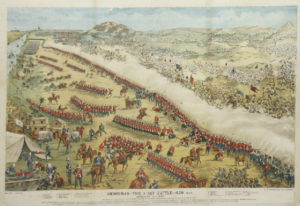In 1907 French waiters went on strike, and won the right to wear facial hair.
Podcast: Play in new window | Download
Subscribe: RSS
In 1907 French waiters went on strike, and won the right to wear facial hair.
Podcast: Play in new window | Download
Subscribe: RSS
It’s not enough to just talk about the history of the Grand Guignol. We also want to bring you a little bit of what it was like to take in a night of horror there. On this special Halloween episode, we bring you three adaptations of Grand Guignol plays: Him!, The Ultimate Torture, and The Kiss of Blood.
Podcast: Play in new window | Download
Subscribe: RSS
The Grand Guignol was a small Parisian theater which regularly produced original works of horror. The theater, which operated from 1897 until 1962, showcased short plays about murder, insanity, dismemberment, disease, and other horrors, much to the delight of regulars and tourists alike. The theater produced over 1,200 original plays during it’s six decades of work, and today occupies a special place in the history of the horror genre. However, the Grand Guignol’s mythic status is sometimes at odds with how plays were actually staged, and how horror effects were achieved on stage. In this episode, we look at the history of the Grand Guignol in general, and how the artists who worked there achieved an atmosphere of terror and dread.
Podcast: Play in new window | Download
Subscribe: RSS
Mahdist Sudan died violently.
The religious state persisted for approximately a decade and a half but after that the British, eager to solidify their influence and control in the region, brought the country to heel. Egypt had never recognized Sudanese independence, and thought of the new country as little more than a renegade province. Under British control and influence, the Anglo-Egyptian forces crushed the independent Sudanese state, making short work of the armed forces. The key to their victory was a new technology: The machine gun.
After the British victory the military and cultural foundations of the Mahdist state were destroyed, and Sudan was soon in the same state of repression that it had previously been in, though instead of dealing with the Ottoman boot, now it suffered under the British.

Podcast: Play in new window | Download
Subscribe: RSS
One of the most high-profile maritime disasters in French history also inspired a famous, and gigantic work of art. In 1816 the French frigate Medusa ran aground in the Bay of Arguin. The captain and several officers escaped on life boats, but 147 people were abandoned on a hastily built raft. For almost two weeks the raft-goers suffered from starvation, dehydration, and malnutrition. The desperate survivors descended into violence and resorted to cannibalism before being rescued (by chance) by another vessel. Of the 147 people abandoned on the raft, ten survived.
A few years later, in 1819, the 25-year-old Romantic painter Theodore Gericault painted a gigantic, larger-than-life painting entitled The Raft of the Medusa. To compose his masterpiece, Gericault sought out dead and decayed bodies, contacted survivors, and memorialized the tragedy like a man possessed.
Related Links:
More on The Raft of the Medusa on the Louvre’s website.
A Narrative of a Voyage to Senegal in 1816 on Project Gutenberg.
Podcast: Play in new window | Download
Subscribe: RSS
Happy New Year! It’s January First, 2015, and you probably have a new calendar. Calendars tend to be irregular, weird, and uneven, but some folks have attempted to smooth that out throughout history.
Below is the Soviet Calendar. Workers were assigned colors, and based on the color assigned to you, that would be your day off.
Related Links:
Read about the Soviet Calendar on History Today (login required)
Convert Gregorian dates into French Republican dates here.
The current time and date according to the Hanke-Henry Permanent Calendar.
Scientific American on the Hanke-Henry Permanent Calendar.
An overview of the Symmetry454 Calendar.
Podcast: Play in new window | Download
Subscribe: RSS
Maximilian’s rule over Mexico was never truly solidified or legitimized, and the would-be emperor faced relentless resistance from liberal Mexican forces led by reformist president Benito Juarez. Eventually the emperor (always just a puppet of the French) would lose his foreign backing, get holed up in a siege, get captured, and eventually die ingloriously in front of a firing squad.
The painting below by Edouard Manet shows the execution of Maximilian and two of his generals by Juarez’s republican forces.
Related Links:
The New York Times in 1865 on the Second Mexican Empire.
The New York Times’ Disunion Blog on the Battle of Puebla and Mexican foreign policy in the Second Empire.
The Grey River Argus on the Queretaro.
A photo purporting to show the execution of Maximilian and two of his generals.
Podcast: Play in new window | Download
Subscribe: RSS
One of the most definitive and dramatic struggles against European monarchy happened in Mexico. France attempted to install Maximilian, a member of Austrian royal family as a puppet emperor of Mexico in the 1860s. The would-be emperor, though, was resisted by one of Mexico’s most successful and well-known presidents, Benito Juarez. The liberal leader led an opposition government, fought against both foreign powers and Mexican conservatives, and destroyed the Second Mexican Empire.
The 1867 painting beleow by Cesare Dell’Acqua, depicts Maximilian accepting the Mexican throne in Trieste, Italy.
Related Links:
Political Legitimation and Maximilian’s Second Empire in Mexico, 1864-1867
Embracing a Sutable Past: Independence Celebrations Under Mexico’s Second Empire, 1864-6
Maximilian and His Mexican Empire
Some images of the flag and coat of arms of Maximilian’s Mexico
Podcast: Play in new window | Download
Subscribe: RSS
© Copyright 2024 - The Weird History Podcast | Portland branding and web design by Upswept Creative